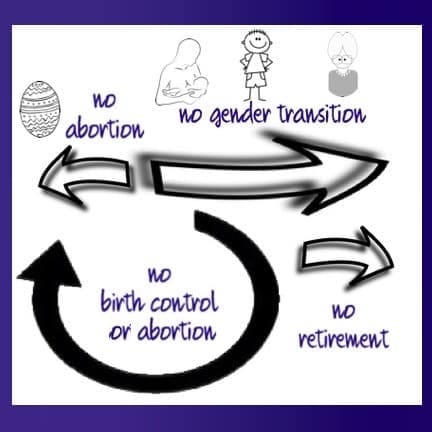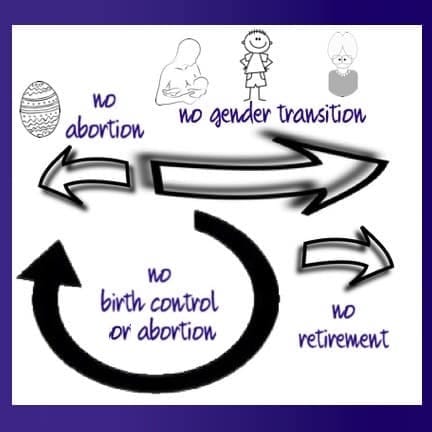A little autonomy diagram: Repro rights and gender
Bans on abortion and gender transition seem to me like arrows pointing in opposite directions: earlier and later. A ban on birth control, meanwhile, seems like an arrow that loops around from the middle of one human life to the beginning of a new one.

Reproductive rights, including birth control and abortion, are heavily grounded in the principle of autonomy over one's own body.
So is gender transition. That's a big expression of autonomy too.
Reproductive rights and gender transition have this in common. Many people make this connection intuitively.
Threats to autonomy: Earlier and later
Today I'd like to put the "today" into Gender Identity Today. This is an election year in the United States, so there's an urgency to certain topics. This is a bit political.
There are attempts to de-facto ban abortion and gender transition by restricting when a person may have an abortion or begin to live in a new gender. The window for abortion gets pushed ever earlier in a pregnancy, while transition gets pushed later in a person's life. Specifically, some U.S. legislatures have proposals to ban abortion only weeks into a pregnancy (they'd like to ban it altogether) and to establish a minimum age of 26 to receive gender-affirming hormones and surgery (again, they'd like to ban it altogether). Demanding that a procedure be done only at a specified time, one that might be unworkable for the person involved, is a way of banning the procedure.
The party that's doing that will ban birth control too if it gets the chance.
I drew this picture
I use a human timeline to visualize these political pressures.
Bans on abortion and gender transition seem to me like arrows pointing in opposite directions: earlier and later.
A ban on birth control, meanwhile, seems like an arrow that loops around from the middle of one human life to the beginning of a new one. I stuck the word "abortion" in there again too. That's because reproductive rights—broadly, both birth control and abortion—are related to the right to gender transition. A teen or adult may see it from this perspective. Those rights are about controlling one's own reproductive parts, making choices about partners, planning parenthood, and being in gendered relationships. Not having access to this kind of healthcare (or simply lacking information about it) underlies many pregnancies — and of course reproductive healthcare affects the earliest part of the human life cycle too, which is why the arrow loops back. This condition (of an individual or a society) can affect a new person.

As a bonus, I stuck a little arrow for "no retirement" in the diagram too. Government assistance, disability benefits and retirement income are generally precarious and are currently making U.S. campaign headlines. A government may limit support as we age as part of its economic vision of more humans born to work longer. It adds a bit more complexity to this diagram.
That's it
I apologize for the brevity, which no one expects of me.
If this image sparks any ideas, including how to draw it more beautifully and insightfully, I enthusiastically welcome others' iterations. You have the right to reproduce it.
